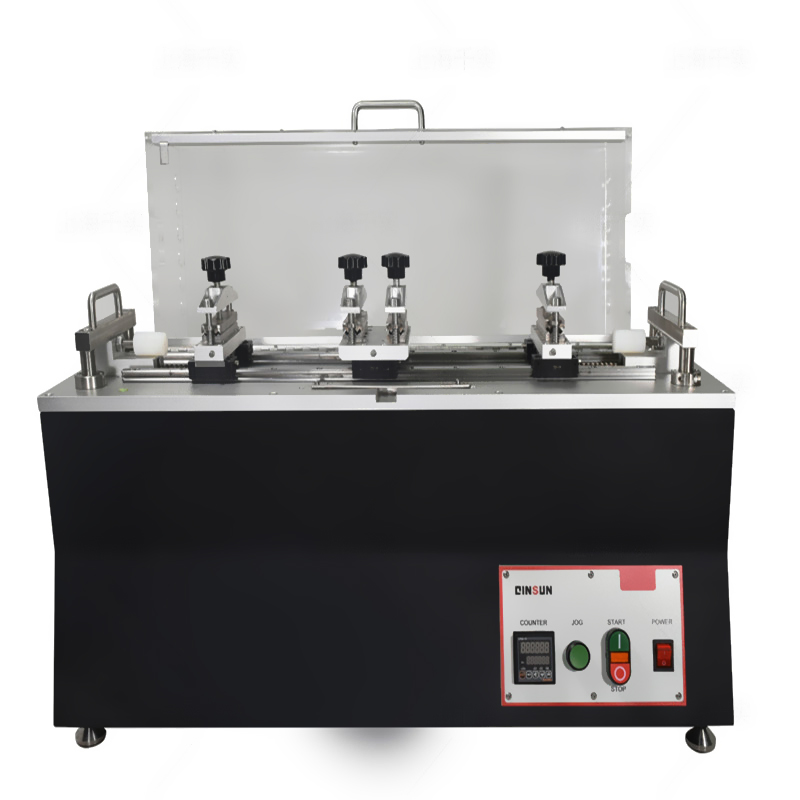
Leather Seam Fatigue Tester: A Comprehensive Explanation from Principle to Appli
2025/08/01

Analysis of Core Technology
The leather seam fatigue tester, designed based on the principles of material mechanics and kinematics, primarily assesses the durability of seams by simulating the cyclic stresses experienced during actual use. The device utilizes a precise crank-connecting rod or cam mechanism to convert the motor's rotational motion into reciprocating motion of the test fixture, ensuring highly consistent trajectory and amplitude with each bending motion. Advanced equipment is typically equipped with a servo control system, enabling precise adjustment of the bending frequency (adjustable from 30 to 120 times/minute) and bending angle (up to 90°) to meet the testing requirements of various standards.
During the test, the device monitors the seam's state in real time using high-precision sensors. Some high-end models also feature an optical detection system that automatically identifies the initial moment of seam cracking. Modern testers generally adopt a modular design. By replacing different fixture components, they can adapt to the testing needs of different leather product categories, such as shoe uppers, bags, and clothing. The addition of temperature and humidity control allows the equipment to simulate various environmental conditions, further enhancing the practical value of the test results.
In-Depth Analysis of Industry Applications
In the footwear industry, seam fatigue testing has become an essential step in the development of high-end footwear. Well-known sports brands often conduct thousands of seam fatigue tests when applying new materials to ensure that areas subjected to frequent flexing during movement do not crack. This test data not only guides the selection of stitching materials and sewing techniques but also provides a scientific basis for product lifespan assessment.
In the automotive interior sector, leather seams are subject to even more stringent requirements. Seat leather must withstand long-term wear and tear, and seam fatigue testing can simulate up to 10 years of wear and tear. Leading automotive suppliers raise testing standards to 3-5 times the industry standard to ensure that seam problems will not occur throughout the vehicle's lifespan. Some testers have also developed specialized multi-axial, compound motion modes to more realistically simulate the complex forces experienced during vehicle operation.
In the luxury leather goods industry, seam quality is considered a crucial indicator of craftsmanship. Top brands require not only basic fatigue testing but also "extreme conditions testing"—assessing seam performance in alternating high and low temperature environments. This type of testing places extremely high demands on equipment stability and accuracy, with temperature fluctuations controlled within ±1°C and bending times measured with an error no greater than 0.05%.
Technological Innovation and Development Trends
Currently, leather seam fatigue testers are evolving towards intelligent and multifunctional features. The latest generation of equipment integrates machine vision systems, capturing microscopic seam deformation in real time and automatically analyzing cracking levels using image algorithms, significantly enhancing the objectivity of test results. Some R&D-level equipment also features force sensor arrays that can map stress distribution across seams, providing data support for structural optimization.
The application of the Internet of Things (IoT) technology enables remote monitoring and data analysis capabilities for testing equipment. Manufacturers can establish distributed testing networks to aggregate and analyze test data from different plant locations in real time, enabling comprehensive control of product quality. Predictive models based on big data analytics can predict actual failure probability based on test data, significantly increasing the application value of test results. Environmental protection is also driving innovation in testing technology. New testers generally adopt energy-saving designs, reducing standby power consumption by over 40%. The use of oil-free guides and low-noise transmission mechanisms improves the working environment. Some manufacturers have also developed cyclical testing modes that optimize motion trajectories to reduce energy consumption, embodying a sustainable design philosophy.
Suggestions for Building a Quality Control System
Establishing a scientific seam quality assessment system requires integrating fatigue testing with other testing methods. Companies are advised to adopt a "step-by-step testing strategy": beginning with basic manual inspections, followed by quantitative testing using specialized equipment, and finally, verification through actual wear testing. Testing frequency should be appropriately determined based on production batches. For critical products, it is recommended that every batch be tested, while sampling testing can be used for routine products.
Data analysis is crucial for enhancing the value of testing. Companies are advised to establish a test database to record the parameter settings, environmental conditions, and test results for each test. By accumulating data over time, performance differences between different material combinations and sewing processes can be analyzed, and an internal "process-performance" correlation model can be established to guide product development.
Personnel training is also crucial. Operators must not only master the use of the equipment but also understand the detailed requirements of the test standards. Regular training on standard interpretation and operational skills is recommended to ensure standardized testing processes and comparable results. Companies with the necessary resources can establish dedicated test engineer positions to oversee specialized tasks such as equipment maintenance, method development, and data analysis.
Previous: Wyzenbeek wear test
N e x t : Horizontal and vertical combustion tester



